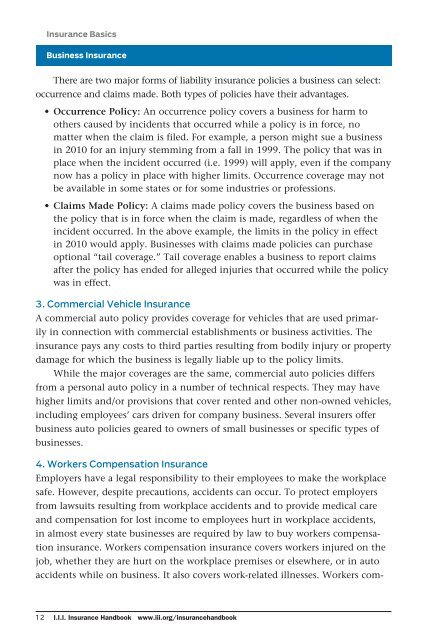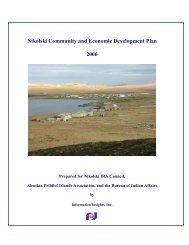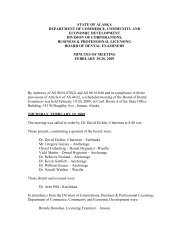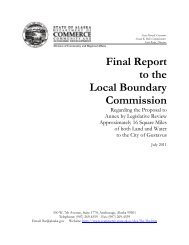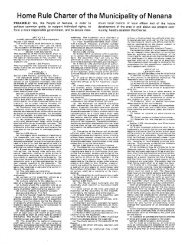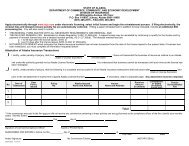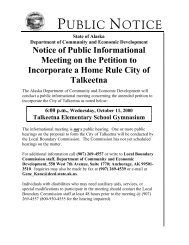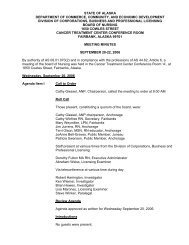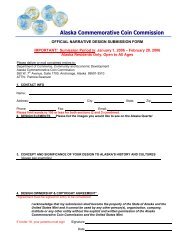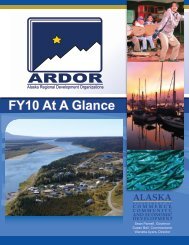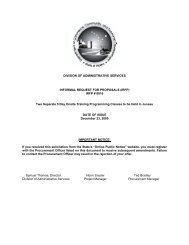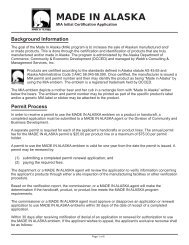Insurance Handbook - Alaska Department of Community and ...
Insurance Handbook - Alaska Department of Community and ...
Insurance Handbook - Alaska Department of Community and ...
Create successful ePaper yourself
Turn your PDF publications into a flip-book with our unique Google optimized e-Paper software.
<strong>Insurance</strong> Basics<br />
Business <strong>Insurance</strong><br />
There are two major forms <strong>of</strong> liability insurance policies a business can select:<br />
occurrence <strong>and</strong> claims made. Both types <strong>of</strong> policies have their advantages.<br />
• Occurrence Policy: An occurrence policy covers a business for harm to<br />
others caused by incidents that occurred while a policy is in force, no<br />
matter when the claim is filed. For example, a person might sue a business<br />
in 2010 for an injury stemming from a fall in 1999. The policy that was in<br />
place when the incident occurred (i.e. 1999) will apply, even if the company<br />
now has a policy in place with higher limits. Occurrence coverage may not<br />
be available in some states or for some industries or pr<strong>of</strong>essions.<br />
• Claims Made Policy: A claims made policy covers the business based on<br />
the policy that is in force when the claim is made, regardless <strong>of</strong> when the<br />
incident occurred. In the above example, the limits in the policy in effect<br />
in 2010 would apply. Businesses with claims made policies can purchase<br />
optional “tail coverage.” Tail coverage enables a business to report claims<br />
after the policy has ended for alleged injuries that occurred while the policy<br />
was in effect.<br />
3. Commercial Vehicle <strong>Insurance</strong><br />
A commercial auto policy provides coverage for vehicles that are used primarily<br />
in connection with commercial establishments or business activities. The<br />
insurance pays any costs to third parties resulting from bodily injury or property<br />
damage for which the business is legally liable up to the policy limits.<br />
While the major coverages are the same, commercial auto policies differs<br />
from a personal auto policy in a number <strong>of</strong> technical respects. They may have<br />
higher limits <strong>and</strong>/or provisions that cover rented <strong>and</strong> other non-owned vehicles,<br />
including employees’ cars driven for company business. Several insurers <strong>of</strong>fer<br />
business auto policies geared to owners <strong>of</strong> small businesses or specific types <strong>of</strong><br />
businesses.<br />
4. Workers Compensation <strong>Insurance</strong><br />
Employers have a legal responsibility to their employees to make the workplace<br />
safe. However, despite precautions, accidents can occur. To protect employers<br />
from lawsuits resulting from workplace accidents <strong>and</strong> to provide medical care<br />
<strong>and</strong> compensation for lost income to employees hurt in workplace accidents,<br />
in almost every state businesses are required by law to buy workers compensation<br />
insurance. Workers compensation insurance covers workers injured on the<br />
job, whether they are hurt on the workplace premises or elsewhere, or in auto<br />
accidents while on business. It also covers work-related illnesses. Workers com-<br />
12 I.I.I. <strong>Insurance</strong> <strong>H<strong>and</strong>book</strong> www.iii.org/insuranceh<strong>and</strong>book


